-
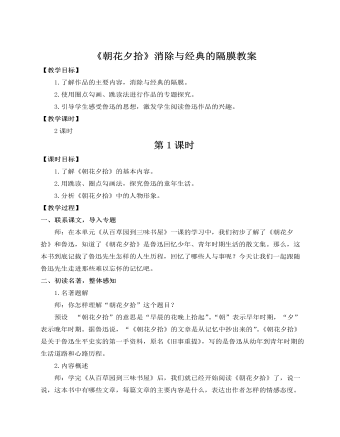
人教部编版七年级语文上册名著导读 《朝花夕拾》 消除与经典的隔膜教案
3.小组合作,交流阅读体会,填写阅读任务卡4.师点评并展示优秀的阅读任务卡【设计意图】本环节侧重寻找《朝花夕拾》中表现鲁迅先生儿童教育观念的地方,通过细节审视,深入体会鲁迅先生对于儿童教育观念的独特认识和深切关怀。在这轻松而有感染力的文字里,我们能真切地感受到鲁迅先生对儿童教育的切身感受。联系现实,让学生对鲁迅先生的儿童教育观的现实意义也有强烈的认同感,从而理解鲁迅先生,理解文本里的情感,拉近与文本的距离。三、汇报探究成果,评选优秀学生1.各小组内汇总专题探究阅读任务卡2.各小组内不记名投票,评选出最优秀的阅读任务卡3.师汇总各小组最优秀的阅读任务卡,在全班展示4.评选优秀汇报者针对最优秀的阅读任务卡和各小组汇报情况,全班填写“《朝花夕拾》阅读汇报评价表”,评选出三位阅读任务卡优秀制作者和一名优秀专题汇报者。课件出示:
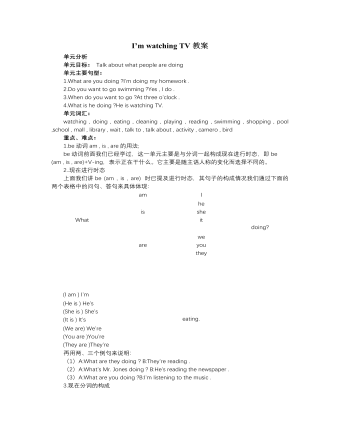
人教版新目标初中英语七年级下册I’m watching TV教案
单元分析单元目标: Talk about what people are doing 单元主要句型:1.What are you doing ?I’m doing my homework .2.Do you want to go swimming ?Yes , I do .3.When do you want to go ?At three o’clock .4.What is he doing ?He is watching TV. 单元词汇:watching , doing , eating , cleaning , playing , reading , swimming , shopping , pool ,school , mall , library , wait , talk to , talk about , activity , camero , bird 重点、难点:1.be动词am , is , are的用法;be动词前面我们已经学过,这一单元主要是与分词一起构成现在进行时态,即be (am , is , are)+V-ing,表示正在干什么。它主要是随主语人称的变化而选择不同的。2..现在进行时态上面我们讲be (am , is , are) 时已提及进行时态,其句子的构成情况我们通过下面的两个表格中的问句、答句来具体体现:3.现在分词的构成现在进行时态中be + V - ing 的构成中V-ing被称为现在分词,它的基本构成是动词原形+ing,但也有些特殊情况,下面分几类说明:(1)一般情况+ing如:read→reading,go→going,do→doing,look→looking,listen→listening,watch→watching.(2)以不发音的e结尾的词,去掉e,再加ing.如:write→writing,skate→skating,type→typing,wake→waking,make→making
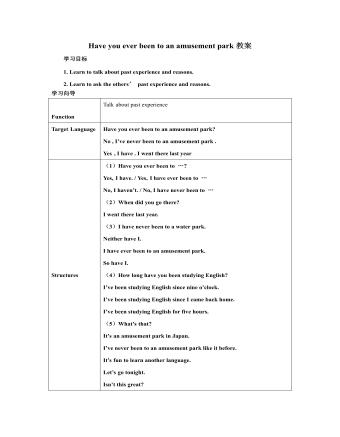
人教版新目标初中英语八年级下册Have you ever been to an amusement park教案
(1)Have you ever been to …? Yes, I have. / Yes, I have ever been to …No, I haven’t. / No, I have never been to …(2)When did you go there? I went there last year. (3)I have never been to a water park. Neither have I. I have ever been to an amusement park. So have I. (4)How long have you been studying English? I’ve been studying English since nine o’clock. I’ve been studying English since I came back home. I’ve been studying English for five hours. (5)What’s that? It’s an amusement park in Japan. I’ve never been to an amusement park like it before. It’s fun to learn another language. Let’s go tonight. Isn’t this great?space museum, amusement park, water park, South America, Peru, Holland, European culture, tour guide, flight attendant, musical instrument, more than, be from, get to, take lessons, neither, discover, graduate, change
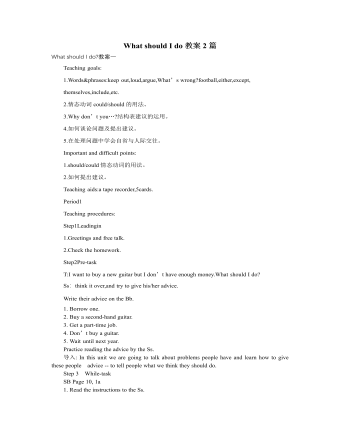
人教版新目标初中英语八年级下册What should I do教案2篇
说明:在帮Li Lei提建议的同时,教育学生如何学好英语。第三课时教学目标1. 语言目标:a) 词汇: Original, in style, haircut, the same as.b) 语言结构:My friend wears the same clothes and has the same haircut as I do.2. 能力目标:大多数学生能够谈论自己喜欢哪种服装,提高查找信息的能力。3. 情感目标:学会如何与朋友相处,要有自己对时尚的看法。教学重点掌握一些重要词汇。教学难点学会谈论问题,并能提出书面建议。◆教学突破首先针对Erin的问题,提出个人的建议,模仿2c部分的对话展开双人交际Pair-work;听老师诵读3a部分的信件,并找出LEFT OUT的问题所在;学生完成3b部分的内容,给Left Out提出书面的建议;学以口头形式提出自己目前存在的某个问题,讲给大家听,让同学们给自己提出一个建议,并作笔录;学生两、三个人分成一组,随意性地进行口语交际,谈论P14的第4部分的某个问题,相互交换意见。
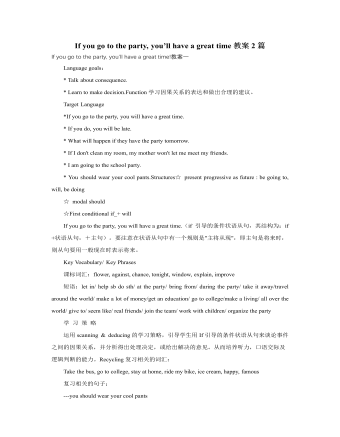
人教版新目标初中英语八年级下册If you go to the party, you’ll have a great time教案2篇
区分宾语从句、定于从句和状语从句宾语从句和状语从句,都叫做主从复合句。宾语从句主要是中考必考的,是初中阶段必掌握的从句,宾语从句主要是掌握三要素,所谓宾语从句,就是宾语在主从复合句当中充当宾语的一个句子,叫做宾语从句。主句的谓语动词是及物动词,后面如果是词或者是短语的话,是简单句,如果是句子的话,肯定是宾语从句。I know that he good at English.就是宾语从句,三要素,一要素是要注意连词,连词一共学了三类连词,一类连词是that口语当中可以省略,就像刚才说的那一句,I hear he is good at English.还有疑问代词、疑问副词,how where when,疑问代词、疑问副词。还有一类连词weather是否的意思,不是状语从句当中的如果,这一定要和如果区分开,这是是否。I don't know if he interested at English。宾语从句要注意if是连词。第二要素是语序,要用陈述举语序。比如说你家有几口人,我们都说How many people are there in you family?但是这是简单句,一旦说成宾语从句,你可以告诉我你家有几口人吗?Could you tell me how many people there are in you family ?
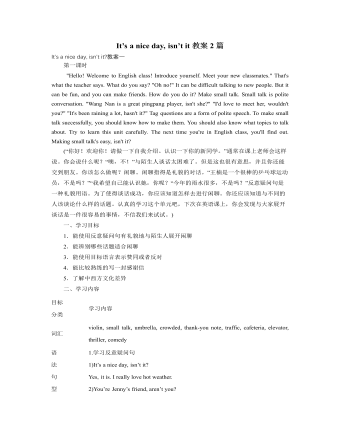
人教版新目标初中英语八年级下册It’s a nice day, isn’t it教案2篇
"Hello! Welcome to English class! Introduce yourself. Meet your new classmates." That's what the teacher says. What do you say? "Oh no!" It can be difficult talking to new people. But it can be fun, and you can make friends. How do you do it? Make small talk. Small talk is polite conversation. "Wang Nan is a great pingpang player, isn't she?" "I'd love to meet her, wouldn't you?" "It's been raining a lot, hasn't it?" Tag questions are a form of polite speech. To make small talk successfully, you should know how to make them. You should also know what topics to talk about. Try to learn this unit carefully. The next time you're in English class, you'll find out. Making small talk's easy, isn't it? (“你好!欢迎你!请做一下自我介绍。认识一下你的新同学。”通常在课上老师会这样说。你会说什么呢?“噢,不!”与陌生人谈话太困难了。但是这也很有意思,并且你还能交到朋友。你该怎么做呢?闲聊。闲聊指得是礼貌的对话。“王楠是一个很棒的乒乓球运动员,不是吗?”“我希望自己能认识她,你呢?“今年的雨水很多,不是吗?”反意疑问句是一种礼貌用语。为了使得谈话成功,你应该知道怎样去进行闲聊。你还应该知道与不同的人该谈论什么样的话题。认真的学习这个单元吧,下次在英语课上,你会发现与大家展开谈话是一件很容易的事情,不信我们来试试。)
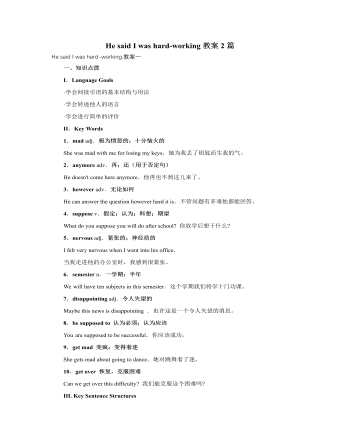
人教版新目标初中英语八年级下册He said I was hard-working教案2篇
This activity introduces some new vocabulary and provide oral practice using the target language.Task 1 . Ask four students to stand in front of the class, and the teacher asks them the following questions as a reporter.1.What are you going to do when you grow up?2.What are you going to do next week?3.What are going to do after school?The students will give different answers, then ask a good student to report what they said.I am going to e a doctor.What did she say?----------She said she was going to be a doctor.I am going to have a party on Friday night.What did he say?-------He said he was going to have a party on Friday night.I am going to do my homework.What did she say ?------ She said she was going to do her homework.I am going home after school.What did she say?-----She said she was going home after school.Say In this unit we are going to learn to use words like to report what someone said.Task 2. Read the instructions. Then ask a student to read the four questions. And write the words on the Bb. Explain what soap opera is.Task 3. Ask the students to Look at the pictures, point out the TV screens in the picture. Ask one girl to read what Marcia said.What did Marcia say? She said She said she was having a surprise party for Lana on Friday night. Repeat the other pictures in the same way.Activity3. Listen and number the pictures in activity 1a.
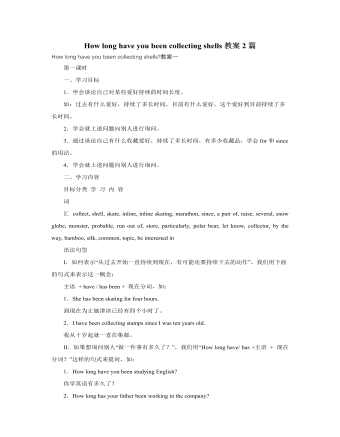
人教版新目标初中英语八年级下册How long have you been collecting shells教案2篇
Step Ⅱ Show the new words on the screen and teach the new words. Read the new words to students and ask them to repeat.Step Ⅲ 3aThis activity introduces new vocabulary and provides reading practice using the target language.In this activity first look at the four pictures.T: What can you see in the pictures?Ss: Four snow globes.T: Right. There are four snow globes in the pictures. And what are they?Ss: They are a monster, two polar bears, two penguins and a birthday cake.Write these words on the blackboard: snow globe; monster; polar bear; penguin and birthday cake. Read them to the class and ask students to repeat each one. Make sure students understand each word.Use a computer to show the E-mail message on the screen and read the message to students.Get students to read the e-mail on their own, and then draw lines connecting each snow globe and its description.Correct the answers.AnswersA line should connect each snow globe picture with the words that describe it in the letter.Step Ⅳ 3bThis activity provides writing practice using the target language.First review Activity 2a on Page 47.Then ask students to complete the message according to Activity 2a.Some partial sentences are given to students. Write about one person's collection.When students work, walk around the room checking the progress and offering help as needed.When they finish, ask some students to read their messages to the class.
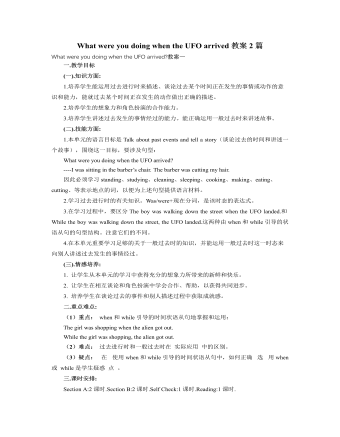
人教版新目标初中英语八年级下册What were you doing when the UFO arrived教案2篇
(一).知识方面: 1.培养学生能运用过去进行时来描述、谈论过去某个时间正在发生的事情或动作的意识和能力,能就过去某个时间正在发生的动作做出正确的描述。 2.培养学生的想象力和角色扮演的合作能力。 3.培养学生讲述过去发生的事情经过的能力。能正确运用一般过去时来讲述故事。 (二).技能方面: 1.本单元的语言目标是Talk about past events and tell a story(谈论过去的时间和讲述一个故事),围绕这一目标,要涉及句型: What were you doing when the UFO arrived? ----I was sitting in the barber’s chair. The barber was cutting my hair. 因此必须学习standing、studying、cleaning、sleeping、cooking、making、eating、cutting、等表示地点的词,以便为上述句型提供语言材料。2.学习过去进行时的有关知识。Was/were+现在分词,是该时态的表达式。 3.在学习过程中,要区分The boy was walking down the street when the UFO landed.和While the boy was walking down the street, the UFO landed.这两种由when和while引导的状语从句的句型结构。注意它们的不同。
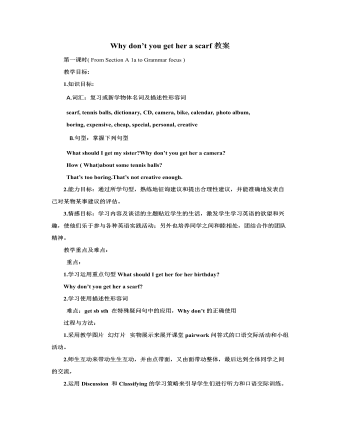
人教版新目标初中英语八年级下册Why don’t you get her a scarf教案
教师带领学生复习有关描述宠物的词汇,采用教师提问学生回答的方进行。如:T:What animals do you think would be good pets?What animals do you think would be bad pets?What do you think are good animals for a six-year-old child?然后学生进行 pairwork 练习。Task two: 师生互动,学习探究 1、播放3a部分的录音,引导学生一边听录音,一边跟读。2、通过听录音学生回答以下问题:Why do you think pot-bellied pigs are popular?What are the advantages and disadvantages of keeping such a pet?教师对学生的回答进行及时点评。3.学习范文,学习重点短语,为下步的模仿写作提供语言素材。T :1. )Have you ever kept a pig as a pet?Do you like pigs? St.:No.…Why don’t you like to keep a pig? St: No.They’re too dirty and lazy(Do you know in some foreign countries like Hollyland, Australia,pigs are the most popular pet.there’s a kind of pig.(图)it has an interesting name? it ‘s called a pot-bellied pig.) Now,let’s learn an article about this kind of interesting pet.2.)play the tapeSt.:Listen and repeat3.)show some Qs on computer(本子St.: read silently,then answerthe Qs(本子)4.)Ask ss. Close book and retell this passage.(what is a pot-bellied pig? Is it a good or bad pet? ) St.: retell it to each other“A pot –bellied pig is a popular pet now…”5.read the article together.St.:.practice reading
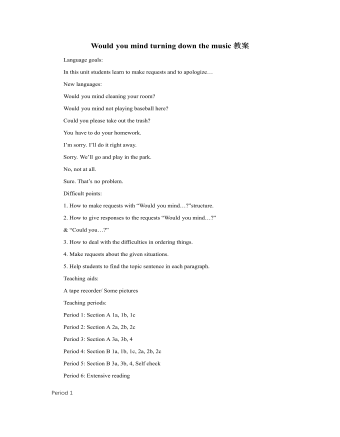
人教版新目标初中英语八年级下册Would you mind turning down the music教案
Step 4. Group work (4)1. Ask a pair of students to read the dialogue. Say, This activity provides speaking, listening and writing practice using the target language.2. Ask students to complete the work in groups.3. Check the answers with the whole class. 4. Explain some of the language points. Step 5. Word review (Self check 1)1. Ask students to read the words and the phrases given. 2. Fill in the blanks with proper forms of these words to complete the sentences. 3. Check the answers with the whole class. Homework:Do activity 2 on page 57 after class. Period 6Teaching aims: 1. Teach vocabulary words and the useful expressions. 2. Enable the students to learn etiquette in different culture. 3. Help the students learn how to behave politely in public places and in daily life. Teaching procedures:Step 1. RevisionHelp students to review the function of making requests through a free talk. Then lead them to the topic of etiquette. Explain the meaning of etiquette. Or, ask students to look it up in the dictionary. Step 2. Pre-reading (Section 1)1. Ask students to read the picture and make a list with their partner about how many rules of etiquette can be seen being broken.
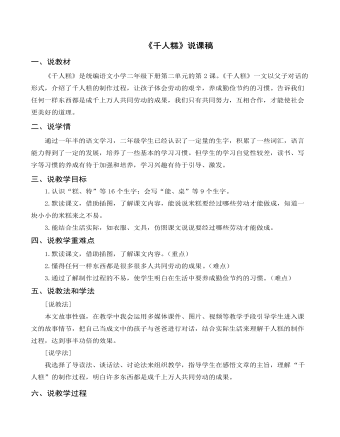
(说课稿)《千人糕》部编人教版二年级上册语文
四、说教学重难点1.默读课文,借助插图,了解课文内容。(重点)2.懂得任何一样东西都是很多很多人共同劳动的成果。(难点)3.通过了解制作过程的不易,使学生明白在生活中要养成勤俭节约的习惯。(难点)五、说教法和学法[说教法]本文故事性强,在教学中我会运用多媒体课件、图片、视频等教学手段引导学生进入课文的故事情节,把自己当成文中的孩子与爸爸进行对话,结合实际生活来理解千人糕的制作过程,达到事半功倍的效果。[说学法]我选择了导读法、谈话法、讨论法来组织教学,指导学生在感悟文章的主旨,理解“千人糕”的制作过程,明白许多东西都是成千上万人共同劳动的成果。
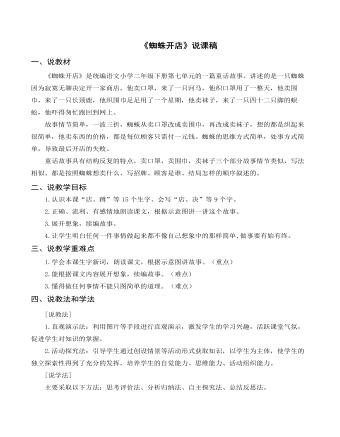
(说课稿)《 蜘蛛开店》部编人教版二年级上册语文
(二)初读故事,学习生字新词。1.打开课本大声朗读课文,遇到不认识的字,我们该怎么办?(借助拼音、查字典、寻求他人帮助等)【设计意图】帮学生提供学习方法,鼓励学生自主识字 2.老师在读课文时,也遇到了“拦路虎”,谁来帮帮我?(出示带拼音的生字)3.去掉拼音,你还能认识他们吗?谁来当小老师领着大家认一认?4.自己试着读一读,你是用什么办法可以把它们记得更牢固? 5.同学们的识字方法真多,相信你们一定把这些字都认识了,我们来开火车读一读吧?6.生字宝宝很调皮分别找了个好朋友让我们认一认,女生先来认一认?男生再来认一认。 7.词语宝宝真有趣,跑到句中,谁能读?出示带有生字的句子,指导朗读。①有一只蜘蛛,每天蹲在网上等着小飞虫落在上面,好寂寞,好无聊啊。②卖什么呢?就卖口罩吧,因为口罩织起来很简单。③口罩好难织啊,蜘蛛用了一整天的工夫,终于织完了。 ④第二天,蜘蛛的招牌又换了,上面写着:“袜子编织店,每位顾客只需付一元钱。” ⑤可是,蜘蛛看到顾客后,却吓得匆忙跑回网上。原来那位顾客竟是一条四十二只脚的蜈蚣。【设计意图】本环节出示的句子都是有代表性的句子,除了句子中都含有本课的生字外,又能让学生在读句子中初步感悟课文内容。
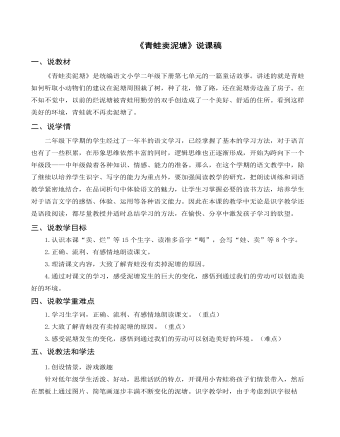
(说课稿)《 青蛙卖泥塘》部编人教版二年级上册语文
三、说教学目标1.认识本课“卖、烂”等15个生字、读准多音字“喝”,会写“娃、卖”等8个字。? 2.正确、流利、有感情地朗读课文。? 3.理清课文内容,大致了解青蛙没有卖掉泥塘的原因。?4.通过对课文的学习,感受泥塘发生的巨大的变化,感悟到通过我们的劳动可以创造美好的环境。四、说教学重难点1.学习生字词,正确、流利、有感情地朗读课文。(重点)2.大致了解青蛙没有卖掉泥塘的原因。(重点)3.感受泥塘发生的变化,感悟到通过我们的劳动可以创造美好的环境。(难点)五、说教法和学法1.创设情景,游戏激趣? 针对低年级学生活泼、好动,思维活跃的特点,开课用小青蛙将孩子们情景带入,然后在黑板上通过图片、简笔画逐步丰满不断变化的泥塘。识字教学时,由于考虑到识字很枯燥,我用小老师带读、开火车读、为分好组的字娃娃起组名的方法激发学生识记生字的兴趣。整节课我力争让孩子们快乐识字,轻松阅读。
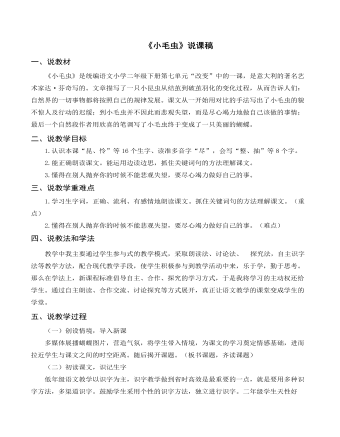
(说课稿)《 小毛虫》部编人教版二年级上册语文
二、说教学目标1.认识本课“昆、怜”等16个生字、读准多音字“尽”,会写“整、抽”等8个字。 2.能正确朗读课文。能运用边读边思,抓住关键词句的方法理解课文。3.懂得在别人抛弃你的时候不能悲观失望,要尽心竭力做好自己的事。三、说教学重难点1.学习生字词,正确、流利、有感情地朗读课文。抓住关键词句的方法理解课文。(重点)2.懂得在别人抛弃你的时候不能悲观失望,要尽心竭力做好自己的事。(难点)四、说教法和学法教学中我主要通过学生参与式的教学模式,采取朗读法、讨论法、?探究法,自主识字法等教学方法,配合现代教学手段,使学生积极参与到教学活动中来,乐于学,勤于思考。那么在学法上,新课程标准倡导自主、合作、探究的学习方式,于是我将学习的主动权还给学生。通过自主朗读、合作交流、讨论探究等方式展开,真正让语文教学的课堂变成学生的学堂。
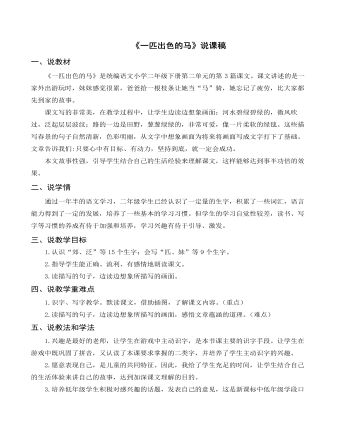
(说课稿)《一匹出色的马》部编人教版二年级上册语文
一、说教材《一匹出色的马》是统编语文小学二年级下册第二单元的第3篇课文。课文讲述的是一家外出游玩时,妹妹感觉很累,爸爸拾一根枝条让她当“马”骑,她忘记了疲劳,比大家都先到家的故事。 课文写的非常美,在教学过程中,让学生边读边想象画面:河水碧绿碧绿的,微风吹过,泛起层层波纹;路的一边是田野,葱葱绿绿的,非常可爱,像一片柔软的绿毯。这些描写春景的句子自然清新,色彩明丽,从文字中想象画面为将来将画面写成文字打下了基础。文章告诉我们:只要心中有目标、有动力,坚持到底,就一定会成功。 本文故事性强,引导学生结合自己的生活经验来理解课文,这样能够达到事半功倍的效果。二、说学情通过一年半的语文学习,二年级学生已经认识了一定量的生字,积累了一些词汇,语言能力得到了一定的发展,培养了一些基本的学习习惯。但学生的学习自觉性较差,读书、写字等习惯的养成有待于加强和培养,学习兴趣有待于引导、激发。三、说教学目标1.认识“郊、泛”等15个生字;会写“匹、妹”等9个生字。2.指导学生能正确、流利、有感情地朗读课文。3.读描写的句子,边读边想象所描写的画面。
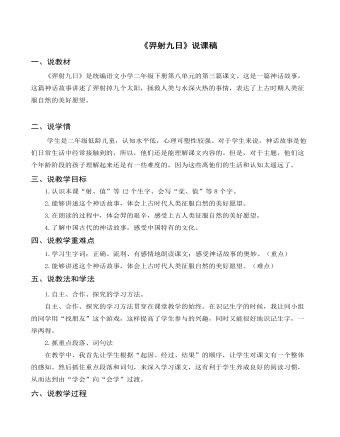
(说课稿)《羿射九日》部编人教版二年级上册语文
三、说教学目标1.认识本课“射、值”等12个生字、会写“觉、值”等8个字。2.能够讲述这个神话故事,体会上古时代人类征服自然的美好愿望。3.在朗读的过程中,体会羿的艰辛,感受上古人类征服自然的美好愿望。4.了解中国古代的神话故事,感受中国特有的文化。四、说教学重难点1.学习生字词;正确、流利、有感情地朗读课文;感受神话故事的奥妙。(重点) 2.能够讲述这个神话故事,体会上古时代人类征服自然的美好愿望。(难点)五、说教法和学法1.自主、合作、探究的学习方法。自主、合作、探究的学习方法贯穿在课堂教学的始终。在识记生字的时候,我让同小组的同学用“找朋友”这个游戏,这样提高了学生参与的兴趣,同时又能很好地识记生字,一举两得。2.抓重点段落、词句法在教学中,我首先让学生根据“起因、经过、结果”的顺序,让学生对课文有一个整体的感知。然后抓住重点段落和词句,来深入学习课文,这有利于学生养成良好的阅读习惯,从而达到由“学会”向“会学”过渡。

(说课稿)《彩色的梦》部编人教版二年级上册语文
一、说教材《彩色的梦》是统编语文小学二年级下册第四单元的一首儿童诗,本单元的课文迸射着想象的火花,内容富有趣味性,《彩色的梦》写的是小朋友彩色铅笔画笔画出了美好的梦境。学习时让孩子们插上想象的翅膀,大胆描绘梦境,培养学生的想象力。二、说教学目标1.认识“盒、聊”等9个生字,会写“彩、梦”等9个生字。理解由生字组成的词语。? 2.朗读课文,体会诗歌描绘的美好意境。? 3.感受想象的乐趣,培养学生爱想象、敢表现的个性品质。三、说教学重难点1.识记生字,朗读课文,体会诗歌描绘的美好意境。(重点) 2.感受梦的色彩,培养学生的想象力。(难点)
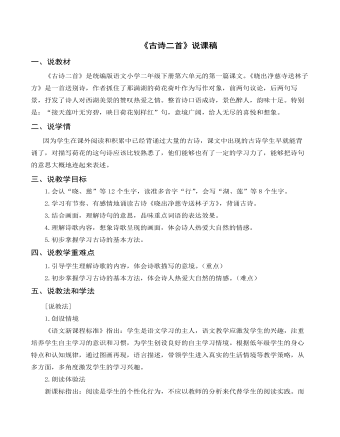
(说课稿)《 古诗二首》部编人教版二年级上册语文
一、说教材《古诗二首》是统编版语文小学二年级下册第六单元的第一篇课文。《晓出净慈寺送林子方》是一首送别诗,作者抓住了那满湖的荷花荷叶作为写作对象,前两句议论,后两句写景,抒发了诗人对西湖美景的赞叹热爱之情。整首诗口语成诗,景色醉人,韵味十足。特别是:“接天莲叶无穷碧,映日荷花别样红”句,意境广阔,给人无尽的喜悦和想象。二、说学情因为学生在课外阅读和积累中已经背诵过大量的古诗,课文中出现的古诗学生早就能背诵了,对描写荷花的这句诗应该比较熟悉了,他们能够也有了一定的学习力了,能够把诗句的意思大概地连起来表述。三、说教学目标1.会认“晓、慈”等12个生字,读准多音字“行”,会写“湖、莲”等8个生字。 2.学习有节奏、有感情地诵读古诗《晓出净慈寺送林子方》,背诵古诗。3.结合画面,理解诗句的意思,品味重点词语的表达效果。4.理解诗歌内容,想象诗歌呈现的画面,体会诗人热爱大自然的情感。5.初步掌握学习古诗的基本方法。
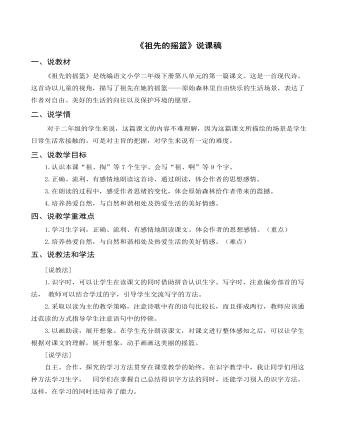
(说课稿)《 祖先的摇篮》部编人教版二年级上册语文
1.学习生字词,正确、流利、有感情地朗读课文。体会作者的思想感情。(重点) 2.培养热爱自然,与自然和谐相处及热爱生活的美好情感。(难点)五、说教法和学法[说教法]1.识字时,可以让学生在读课文的同时借助拼音认识生字。写字时,注意偏旁部首的写法, 教师可以结合学过的字,引导学生交流写字的方法。 ?? 2.采取以读为主的教学策略,注意诗歌中有的语句比较长,而且排成两行,教师应该通过范读的方式指导学生注意语句中的停顿。 ??3.以画助读,展开想象。在学生充分朗读课文,对课文进行整体感知之后,可以让学生根据对课文的理解,展开想象,动手画画这美丽的摇篮。[说学法]自主、合作、探究的学习方法贯穿在课堂教学的始终。在识字教学中,我让同学们用这种方法学习生字,?同学们在掌握自己总结得识字方法的同时,还能学习别人的识字方法。这样,在学习的同时还培养了能力。





















